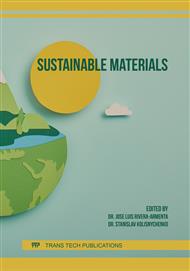[1]
B. Scrosati, and J. Garche. Lithium batteries: Status, prospects and future. Journal of Power Sources, 195 (2010), 2419-2430.
DOI: 10.1016/j.jpowsour.2009.11.048
Google Scholar
[2]
V. Subramanian, C. Luo, A. M. Stephan, K. S. Nahm, S. Thomas, and B. Wei. Supercapacitors from Activated Carbon Derived from Banana Fibers. The Journal of Physical Chemistry C, 111 (2007), 7527-7531.
DOI: 10.1021/jp067009t
Google Scholar
[3]
L. Jiang, G. W. Nelson, S. O. Han, H. Kim, I. N. Sim and J. S. Foord. Natural Cellulose Materials for Supercapacitors. Electrochim. Acta 192 (2016), 251-258.
DOI: 10.1016/j.electacta.2015.12.138
Google Scholar
[4]
K. L. Ong, A. Kurniawan , A. C. Suwandi, C. X. Lin, X. S. Zhao, and S. Ismadji. A facile and green preparation of durian shell-derived carbon electrodes for electrochemical double-layer capacitors. Prog. Nat. Sci. Mater. Int., 22 (2012), 624-630.
DOI: 10.1016/j.pnsc.2012.11.001
Google Scholar
[5]
E. Y. L. Teo, L. Muniandy, E. P. Ng, F. Adam, A. R. Mohamed, R. Jose and K. F. Chong. High surface area activated carbon from rice husk as a high performance supercapacitor electrode. Electrochim. Acta., 192 (2016), 110-119.
DOI: 10.1016/j.electacta.2016.01.140
Google Scholar
[6]
A. G. Dumanli and A.H. Windle. Carbon fibres from cellulosic precursors: a review. Journal of Material Science, 47 (2012), 4236–4250.
DOI: 10.1007/s10853-011-6081-8
Google Scholar
[7]
A. Rahman. Study on modified pineapple leaf fiber. Journal of Textile and Apparel Technology and Management, 7 (2011) 1–16.
Google Scholar
[8]
B. Zhu, et al. Pyrolyzed polyaniline and graphene nano sheet composite with improved rate and cycle performance for lithium storage. Carbon, 92 (2015), 354-361.
DOI: 10.1016/j.carbon.2015.05.051
Google Scholar
[9]
H. Fan, H. Wang, N. Zhao, X. Zhang, J. Xu. Hierarchical nanocomposite of polyaniline nanorods grown on the surface of carbon nanotubes for high-performance supercapacitor electrode, Journal of Material Chemistry, 22 (2012), 2774-2780.
DOI: 10.1039/c1jm14311e
Google Scholar
[10]
N. Kengkhetkit, and T. Amornsakchai. Utilization of pineapple leaf waste for plastic reinforcement1. A novel extraction method for short pineapple leaf fiber. Industrial Crops and Productions, 4 (2012), 55-61.
DOI: 10.1016/j.indcrop.2012.02.037
Google Scholar
[11]
J. Sodtipinta, C. Ieosakulrat, N. Poonyayant, P. Kidkhunthod, N. Chenlek, T. Amornsakchai and P. Pakawatpanurut. Interconnected open-channel carbon nanosheets derived from pineapple leaf fiber as a sustainable active material for superconductors. Indistrial Creps & Products. 104 (2017), 13-20.
DOI: 10.1016/j.indcrop.2017.04.015
Google Scholar
[12]
Y. Miao, Y. Huang, W. Fan and T. Liu. Electrospun polymer nanofiber membrane electrodes and electrolyte for highly flexible and foldable all-solid-state superconducitors. Royal society of chemistry. 5 (2015), 26189-26196.
DOI: 10.1039/c5ra00138b
Google Scholar
[13]
X. Cheng, R. Zhang, C. Zhao, F. Wei, J. Zhang and Q. Zhang. A Review of Solid Electrolyte Interphases on Lithium Metal Anode. Advanced Science. 3 (2016), 1-20.
DOI: 10.1002/advs.201670011
Google Scholar
[14]
H. Ru, K. Xiang, W. Zhou, Y. Zhu, X. S. Zhao and H. Chen. A Bean-dreg-derived carbon materials used as superior anode material for lithium-ion batteries. Electrochimica Acta. 222 (2016), 551-560.
DOI: 10.1016/j.electacta.2016.10.202
Google Scholar
[15]
I. Elizabeth, B. P. Singh, S. Trikha and S. Gopukumar. Bio-deviced hierarchically macro-meso-micro porous carbon anode for lithium/sodium ion batteries. Journal of Power Sources.329 (2016), 412-421.
DOI: 10.1016/j.jpowsour.2016.08.106
Google Scholar
[16]
X. Sun, X. Wang, N. Feng, L. Qiao, X. Li and D. He. A new carbonaceous material derived from biomass source peels as an improved anode for lithium ion batteries. Journal of Analytical and Applied Pyrolysis. 101 (2013), 181-185.
DOI: 10.1016/j.jaap.2012.12.016
Google Scholar
[17]
O. Fromm, A. Heckmann, U. C. Rodehorst, J. Frerichs, D. Becker, M. winter and T. Placke. Carbons from biomass precursors as anode materials for lithium ion batteries: New insights into carbonization and graphitization behavior and into their correlation to electrochemical performance. Carbon. 128 (2018), 147-163.
DOI: 10.1016/j.carbon.2017.11.065
Google Scholar
[18]
X. Huang Fabrication and Properties of Carbon Fibers. Materials, 2 (2009), 2369-2403.
Google Scholar
[19]
Y. R. Rhim, D. Zhang, D. H. Fairbrother, K. A. Wepasnick, K. J. Livi, R. J. Bodnar, and D. C. Nagle. Changes in electrical and microstructural properties of microcrystalline cellulose as function of carbonization temperature. Carbon. 48 (2010), 1012-1024.
DOI: 10.1016/j.carbon.2009.11.020
Google Scholar



